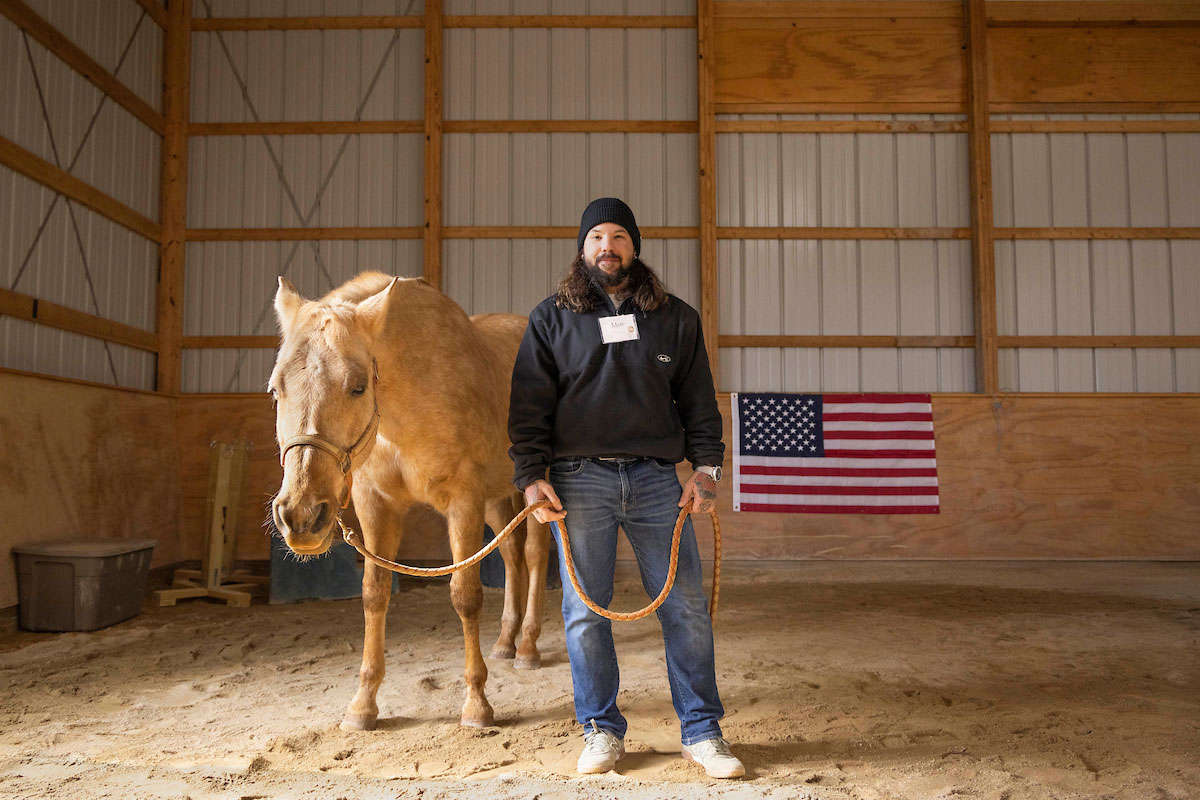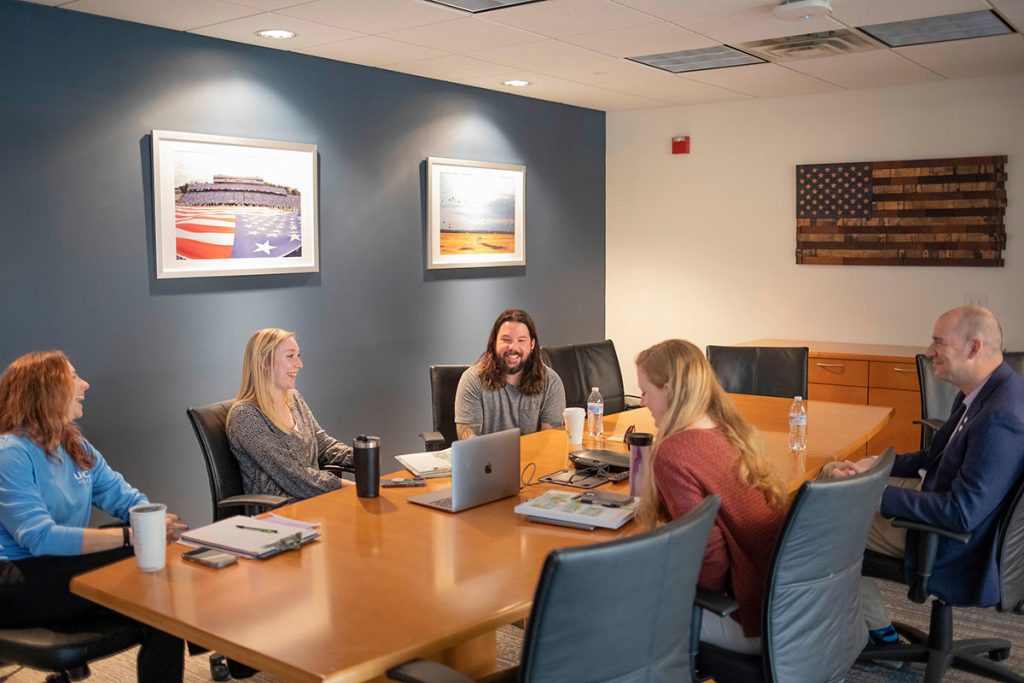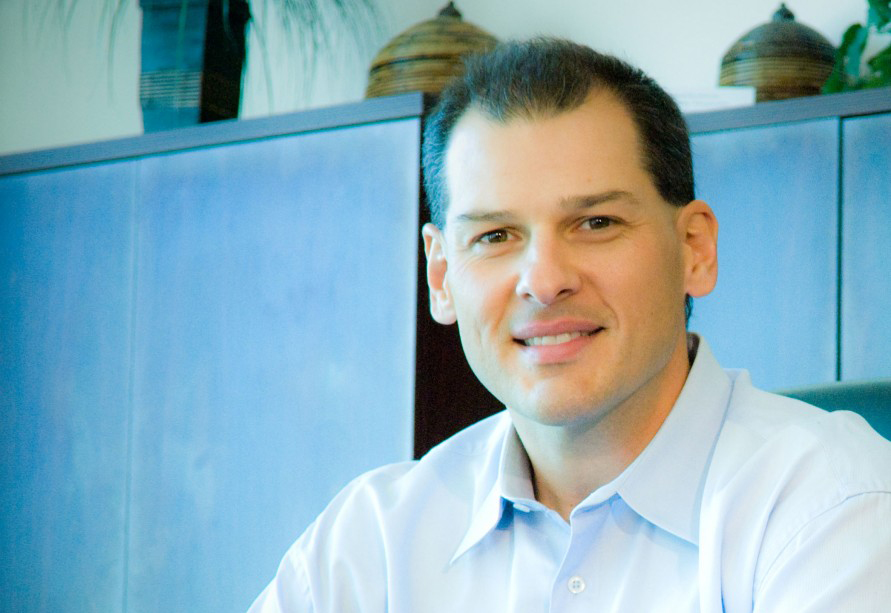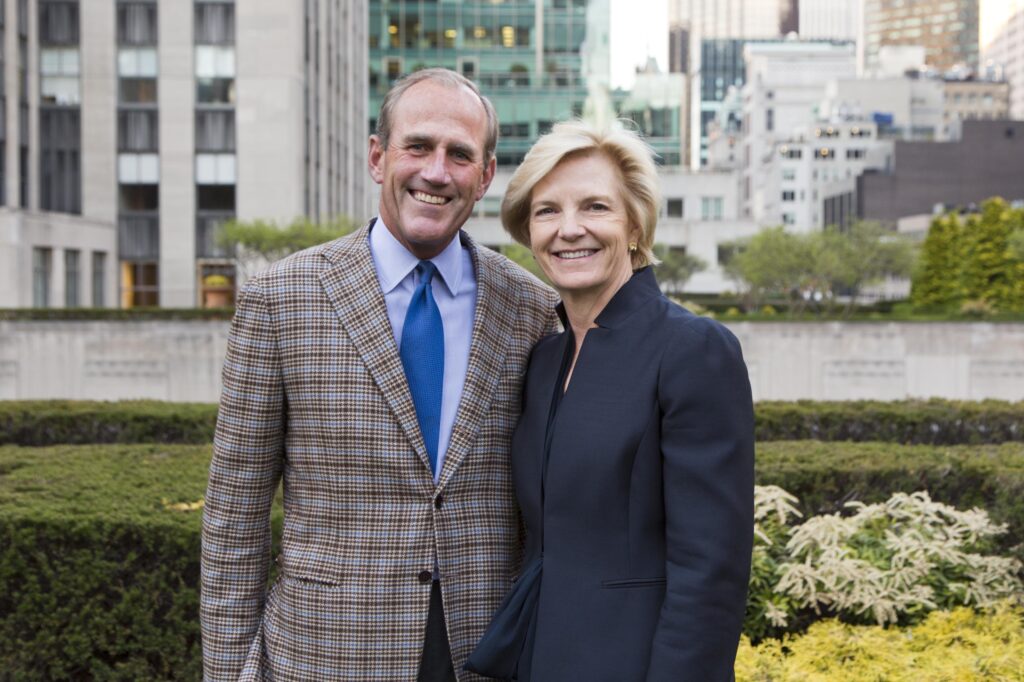Helping Veterans Thrive
March 21, 2023

Veteran Matthew Colon particpated in equine therapy at Clear Winds Farm as part of the THRIVE Program’s multi-week outpatient program. (Photo by Jeyhoun Allebaugh)
An empowering clinical outreach program at UNC-Chapel Hill offers veterans and first responders new hope through holistic health care.
“There’s this narrative that veterans have traumatic brain injury and they’re all screwed up, depressed, alcoholics, and even suicidal,” said Justin Ball, a 23-year veteran of the military Special Operations community. “And this narrative builds.”
Ball spent several years as a U.S. Special Operations Forces medic, where he was able to utilize some of the top medical services available throughout the Department of Defense. He embarked on many missions throughout his active duty, and while he didn’t sustain any life-threatening injuries, Ball said his body endured a lot of wear and tear — including multiple concussions.
When he officially retired from the military in 2021, Ball struggled. Part of his challenge was adjusting to the change of pace. But another major aspect was not knowing whether he had suffered undiagnosed injury or needed medical treatment, physically and mentally. He had been around explosions for years. He had experienced headaches, sinus pressure and jaw pain. He wondered, did that impact his brain? Did he have a traumatic brain injury (TBI)? “You have all these unknowns,” he said.
He no longer had access to the top notch medical care he’d been a part of and worked with in the military. Which is why, when he learned about the THRIVE Program, “there couldn’t have been better news,” Ball said.
How the THRIVE Program began
The THRIVE (Transforming Health and Resilience in Veterans) Program was established at UNC-Chapel Hill as a community-based clinical outreach program to offer veterans and first responders holistic health care, particularly those who are experiencing the effects of post-traumatic stress, traumatic brain injury and musculoskeletal related conditions.
Founded in June 2021 inside the Matthew Gfeller Center in the UNC College of Arts and Sciences and funded by a $12.5 million gift from the Avalon Action Alliance, the collaborative program is the brainchild of two Carolina researchers: Jason Mihalik and Shawn Kane. The duo began working together in 2010, when Chancellor Kevin Guskiewicz (then a professor of exercise and sport science) founded the Matthew Gfeller Center as a leading epicenter for traumatic brain injury research. Kane was an active duty Special Operations Forces soldier and physician at the time, and he and Mihalik were researching active duty service members and TBI-related case studies through the center. When Kane retired from the U.S. Army in 2018 and joined the UNC Department of Family Medicine, he and Mihalik wanted to expand their work to help veterans as well.
“The idea of setting up a veteran-related program was always part of the plan,” Kane, the THRIVE Program’s chief medical officer and primary care physician, said. “We knew we wanted to do something with veterans’ health, to study the impacts of TBIs over their careers and just overall veteran health.”
After several months of working to secure location space and program planning, the first THRIVE Program participant arrived in April 2022. As of October 2022, the program had seen more than 27 participants, ranging in age from 24 to early 70s, and primarily men, though two women have participated — a number that program coordinators hope to increase.

The THRIVE Program experience
Each THRIVE Program participant completes an application before arriving and takes part in a two-and-a-half-day evaluation. All participants are treated regardless of insurance coverage or ability to pay. Currently, the THRIVE Program team sees an average of two new participants each week but is only limited by its physical space, pending ongoing development opportunities to expand the THRIVE Program’s physical footprint.
A holistic, interdisciplinary, collaborative approach is utilized, meaning the participant sees upwards of 12 providers from the following specialties: psychiatry, speech-language pathology, neuropsychology, clinical pharmacy, nutrition, physical medicine and rehabilitation, vestibular physical therapy, clinical psychology, athletic training, and family and sports medicine.
The THRIVE Program visit begins with “the fishbowl,” where the entire medical team and staff members sit with the veteran as he or she shares their entire story. The session, Mihalik said, while sometimes intimidating for the veteran, is empowering — both for the veteran to be fully heard and for the clinicians to better understand what success means to the individual.
For some, success means complete recovery. But for other participants, the goal is different. “We may have someone come in and say, ‘My goal is to have lunch at my kid’s school and not feel like I have to sit with my back against the wall,’” Mihalik said.
After the fishbowl, the program participant meets with each clinician individually for evaluation, for minimally one hour. The culmination of the two-and-a-half-day visit is a comprehensive, detailed report of next steps and recommendations, which THRIVE Program case manager Sarah Marshburn, a social work practitioner, helps coordinate with the veteran’s individual medical providers in his or her hometown to allow for a continuum of care. “We are meant to be a support service, not a replacement for their long-term care,” Marshburn said. “They look at the recommendations as a roadmap.”
“We look at it more as the whole body,” Dr. Kane, who served as a physician in the U.S. Army for 27 years, said. “If you’ve had a TBI or a concussion or PTSD, and if you have bad back, hip, neck pain, then that’s probably going to impact your brain. So we want to help from an overall brain health standpoint: nutrition, exercise, looking at it from a whole person standpoint.
“If we just fix your brain, but you still have a bad back, you still won’t be happy and not optimized and you won’t be able to thrive. That’s our whole goal — to help the veterans and first responders get back to the maximum quality of life possible.”
After the THRIVE Program’s first programming phase, select participants may opt to attend a more intensive, multi-week outpatient program. This second program phase combines group therapy with individualized care based on the veterans’ and first responders’ needs.
Providing answers
Master Sergeant (retired) Sam Rodriguez, the THRIVE Program’s veteran outreach and program coordinator, is a U.S. Special Forces veteran who served in the military for 29 years. He is with the participants in the clinic Tuesday through Thursday and spends Mondays and Fridays on outreach, whether emailing, calling or meeting in-person with potential participants located within North Carolina.
Those veterans, Rodriguez said, often have a simple reason for expressing interest. “They just want to be themselves again. They don’t know why what’s happening to them is happening. So the biggest thing we can do is provide answers.”
“This program calms a lot of those questions that haunt every veteran,” Ball echoed.
Thirty-nine-year-old Matthew Colon medically retired from the military in 2014 after 12 years of service. Initially, while trying to manage his traumatic brain injury symptoms, Colon was sent to a TBI clinic, where he received medication to combat his migraines and other symptoms. Still, he said, it was difficult to try and manage multiple diagnoses. “Do I have TBI today or PTSD, or anger management?” Colon said. “What am I trying to tackle? It gets very confusing.”
His first day at the THRIVE Program was intense. He had a splitting headache and was exhausted. But as the meetings continued into day two, the holistic, all-encompassing approach felt like a “discovery,” he shared. During one session with a physical therapist, the therapist moved Colon through a simple neck exercise. That physical release, he said, led to a mental release as well. Each appointment built on the previous one, with clinicians that Colon described as loving, motivated and collaborative. By the time he left, he said “it felt like, ‘we are going to tackle this together, we won’t just send you to a bunch of appointments and hope it works.’”
Now back home in Burlington, North Carolina, his health doesn’t feel as overwhelming. “It’s not like I’m trying to put the pieces of the puzzle together alone. I have so much assistance through this program, and it feels like they are shuffling the pieces right along with me.”
The THRIVE Program also accomplishes this through the gift of time. In today’s health care environment, doctors typically do not have more than 30 minutes to see a patient. Often, an appointment is capped at 15 minutes, whether at the VA or through a primary care provider. As such, Ball said, that often means deciding on two of your 10 worrying symptoms to discuss with a physician on a particular visit. That can be frustrating not only to the patient, but to the physician as well.
Ball came to the THRIVE Program in July. “It was the first time I could go through a program where I didn’t feel rushed or triaged,” he said. Sitting down with the experts in the room for the introductory fishbowl storytelling session, he thought to himself, ‘This is like a $20,000 appointment. All these experts, listening to me.’ “The gratitude of that — it was sort of overwhelming.”
Since returning home, Ball has started meditating, a practice he tried, unsuccessfully, to adopt for more than seven years. He’d utilized apps, retreats and various programs, but nothing had worked. With the clinicians at the THRIVE Program, “The light bulb finally came on,” Ball said.
He also returned home with a new confidence in his own health. He felt assured that he didn’t have significant TBI and that his diet, nutrition and overall wellness approach were on track. He works as a clinical social worker and has sent several of his clients to the THRIVE Program.
Rewarding for all
The THRIVE Program staff and clinicians feel the magnitude of those success stories, as well. When asked what it has meant to him to work with this program, Rodriguez paused, overcome with emotion. “It’s everything.” He recalled a conversation with the spouse of a veteran who had died from a brain injury. She talked about how her husband had brought a piece of the war home with him that he couldn’t get rid of.
“What does a soldier, a service member, a first responder do?” Rodriguez asked. “They learn to fight back and pick up whatever weapon they can find, whether that is alcohol, prescription drugs or different things that aren’t healthy for them. They have to find a way of getting through that — and one way is through our program.”
In talking to other THRIVE Program participants, Ball said several confessed that the program sounded too good to be true. They were skeptical and reticent upon arriving. But after returning home, treatment plan and coordination in-hand, they were rejuvenated and hopeful.
“I love how the team up there doesn’t care how many years you did, or whether you were a Green Beret,” Ball said, “They are just there to help people.”
By Anna Katherine Clemmons, University Development



